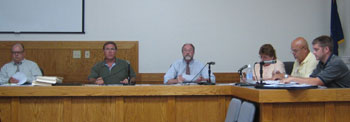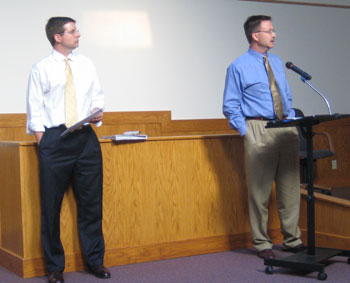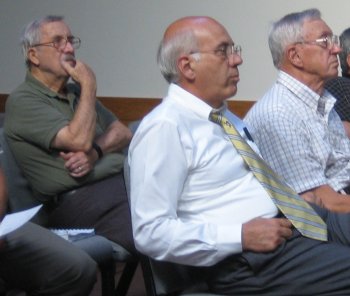- By Dan Veaner
- News
 Print
Print
The Lansing Sewer Committee met a major milestone last week when they presented their engineer's report to the Lansing Town Board. The 1/2" thick document defines the project scope, goals, environmental impact, benefits and costs of bringing sewer to the Town of Lansing. This official transfer of the project from the committee to the Town Board will set in motion public information meetings and further action by the Board that could make the sewer a reality. "We are delivering a draft engineers' report that lays the basis of understanding for how a sewer benefit district could unfold in the greater South Lansing Area," said Town Engineer David Herrick as he and engineer Jim Blum explained the document to the Board.

(Right to left) Town Attorney Guy Krogh, Supervisor Steve Farkas,
Deputy Supervisor Bud Shattuck, Councilwoman Connie Wilcox,
Councilmen Marty Christopher and Matt Besemer
Initially the sewer is divided into two projects. The first is a 19,300 foot forced main trunk sewer that will be made of pipe ranging between 10 and 24 inches in diameter. This project will include three pump stations and is estimated to cost $7,290,000. The second part is a collection system that is planned for the most densely populated portion of the proposed sewer district. This is the portion of the system that homes and businesses hook up to, consisting of 86,900 feet of pipe ranging from 4 to 12 inches in diameter at an estimated cost of $10,950,000.
While everyone within the district will contribute to the trunk sewer, only those in the initial service area will contribute to the collection system. The committee worked for months to come up with a complicated formula for how residents and businesses will be charged. Residential properties will be charged based on dwelling units and the size of the property. Vacant properties will be charged based on size and other properties such as businesses will be charged based on water usage.

Engineers Jim Blum (left) and David Herrick present the
report to the Board
The initial service area was a bone of contention when Dr. Barry Pollack challenged the plan to provide service to only a portion of the sewer district. "Over time there will be opportunities to extend additional mains depending on neighborhood need, support, or additional funding that becomes available to help lower that cost for us," explained Herrick. But Pollack replied, "You don't have a solid plan as to getting sewer service to those other properties. So we may never see service." Herrick said that he wouldn't say there would never be service in those properties, and that they have an understanding of how additional pipes could be laid. But later in the meeting Town officials discussed getting more complete answers to that and other questions that may arise before the first public hearing in September.
Costs of the project include both repayment of the capital project loans and operational costs that include sewage treatment by the Cayuga Heights Treatment Plant. So far the Town has secured $6,383,000 in grant funding and the Sewer Committee is still looking for other funding from the County and private donors to further reduce the cost to residents. "The big issue is the unknown," said Farkas. "And the unknown is the cost." He said that the costs presented in the Engineer's Report are the 'worst case scenario' that would mean $854 per year for residents in the initial service area, and $148 annually for residents in the sewer district who are not in the initial area.

Sewer Committee members attended to show support. Among those
who attended were(Left to right) Frank Moore, who is the Village of
Lansing representative on the committee, Andy Sciarabba and Noel Desch
There are three reasons why this is a 'worst case scenario.' The first has to do with population growth and development. The cost of the sewer is fixed, but as more homes are built there are more taxpayers to share those costs. Therefore the annual cost to each individual is less. With an estimated 100 new homes per year the highest costs will be in the first years of the project, and they will go down through the life of the loan.
The second has to do with the loan the Town secures. The figures presented to the Board are based on a 5.25% public market bond, but the Town hopes to secure a 3% State Revolving Fund loan. If the lower percentage loan can be obtained it will reduce the annual cost for those in the initial service area from $854 to $735.
The third reason has to do with additional funding that the Sewer Committee and Town officials hope to secure. A subcommittee comprised of Andy Sciarabba and Noel Desch has been meeting with County officials, Cornell and possible private donors. They have floated some creative proposals that combine loan guarantees with outright gifts. If they are completely successful their efforts could further lower the total annual cost for homes in the initial service area to $584.
Sciarabba and Desch are also working on garnering public support for the project. The pair attended a Board of Education meeting nearly two weeks ago to present facts about the sewer and to ask the school board to draft a resolution of support for the sewer project. Sciarabba has said that he considers the school district's support key to helping gain wider public support.
The pair also asked for a donation, and explained how growth in the Town, increased by the presence of the sewer, would mean as much as $225,000 or additional tax revenue for the schools in the first year alone. School board members noted that they are not sure whether it is even legal for the school district to contribute, and there are other obstacles such as a public vote on the contribution. But they agreed to look into the legalities and further discuss whether they even want to pursue it.
The Sewer Committee has worked for more than two years to come up with a viable project, ironing out obstacles and working on ways to make the project more affordable. Even though the project has been turned over to the board Town officials see a continuing role for the group as it seeks public support and additional funding for the project. Supervisor Steve Farkas says Town officials are considering creating a department of public works as Lansing's sewer and water responsibilities grow. He floated the idea of evolving the group into an oversight committee for that department.
Town Attorney Guy Krogh explained the ongoing process to residents who were confused about the timetable. If the Town Board creates a sewer district residents within the district will have 30 days from the creation date to petition to hold a permissive referendum. If the sewer is passed, or if there is no referendum, the project will be constructed. If it is defeated the project will be ended. If the project is not approved by the State Comptroller's office it would also be stopped. "The voters could pass it 100% and the State Comptroller could still shoot it down," Krogh explained. Herrick noted that the time is right for the project, because Lansing is unique in having secured bond act monies for the trunk and collection systems, rare in the State.
But Krogh explained that the 30 days does not start now -- the evening's action was merely for the Town Board to accept the sewer proposal. "Next there would be public informational hearings, some of which are formally required, some of which are extra to make sure the word gets out." He noted that there would be other steps including a new environmental impact study, and estimated it would be two to three months before the final public hearing would be held to determine whether the district should be conditionally formed. At that point the Town Board could create the district, and that is when the 30 day petition window would begin.
The Board set the first public information session September 6th at 7:00 PM The Board plans to set a second information session in their September meeting. Meanwhile information is posted at http://www.lansingsewers.com/ and the ongoing story is covered in this publication.
----
v2i32

(Right to left) Town Attorney Guy Krogh, Supervisor Steve Farkas,
Deputy Supervisor Bud Shattuck, Councilwoman Connie Wilcox,
Councilmen Marty Christopher and Matt Besemer
Initially the sewer is divided into two projects. The first is a 19,300 foot forced main trunk sewer that will be made of pipe ranging between 10 and 24 inches in diameter. This project will include three pump stations and is estimated to cost $7,290,000. The second part is a collection system that is planned for the most densely populated portion of the proposed sewer district. This is the portion of the system that homes and businesses hook up to, consisting of 86,900 feet of pipe ranging from 4 to 12 inches in diameter at an estimated cost of $10,950,000.
While everyone within the district will contribute to the trunk sewer, only those in the initial service area will contribute to the collection system. The committee worked for months to come up with a complicated formula for how residents and businesses will be charged. Residential properties will be charged based on dwelling units and the size of the property. Vacant properties will be charged based on size and other properties such as businesses will be charged based on water usage.

Engineers Jim Blum (left) and David Herrick present the
report to the Board
The initial service area was a bone of contention when Dr. Barry Pollack challenged the plan to provide service to only a portion of the sewer district. "Over time there will be opportunities to extend additional mains depending on neighborhood need, support, or additional funding that becomes available to help lower that cost for us," explained Herrick. But Pollack replied, "You don't have a solid plan as to getting sewer service to those other properties. So we may never see service." Herrick said that he wouldn't say there would never be service in those properties, and that they have an understanding of how additional pipes could be laid. But later in the meeting Town officials discussed getting more complete answers to that and other questions that may arise before the first public hearing in September.
Costs of the project include both repayment of the capital project loans and operational costs that include sewage treatment by the Cayuga Heights Treatment Plant. So far the Town has secured $6,383,000 in grant funding and the Sewer Committee is still looking for other funding from the County and private donors to further reduce the cost to residents. "The big issue is the unknown," said Farkas. "And the unknown is the cost." He said that the costs presented in the Engineer's Report are the 'worst case scenario' that would mean $854 per year for residents in the initial service area, and $148 annually for residents in the sewer district who are not in the initial area.

Sewer Committee members attended to show support. Among those
who attended were(Left to right) Frank Moore, who is the Village of
Lansing representative on the committee, Andy Sciarabba and Noel Desch
There are three reasons why this is a 'worst case scenario.' The first has to do with population growth and development. The cost of the sewer is fixed, but as more homes are built there are more taxpayers to share those costs. Therefore the annual cost to each individual is less. With an estimated 100 new homes per year the highest costs will be in the first years of the project, and they will go down through the life of the loan.
The second has to do with the loan the Town secures. The figures presented to the Board are based on a 5.25% public market bond, but the Town hopes to secure a 3% State Revolving Fund loan. If the lower percentage loan can be obtained it will reduce the annual cost for those in the initial service area from $854 to $735.
The third reason has to do with additional funding that the Sewer Committee and Town officials hope to secure. A subcommittee comprised of Andy Sciarabba and Noel Desch has been meeting with County officials, Cornell and possible private donors. They have floated some creative proposals that combine loan guarantees with outright gifts. If they are completely successful their efforts could further lower the total annual cost for homes in the initial service area to $584.
Sciarabba and Desch are also working on garnering public support for the project. The pair attended a Board of Education meeting nearly two weeks ago to present facts about the sewer and to ask the school board to draft a resolution of support for the sewer project. Sciarabba has said that he considers the school district's support key to helping gain wider public support.
The pair also asked for a donation, and explained how growth in the Town, increased by the presence of the sewer, would mean as much as $225,000 or additional tax revenue for the schools in the first year alone. School board members noted that they are not sure whether it is even legal for the school district to contribute, and there are other obstacles such as a public vote on the contribution. But they agreed to look into the legalities and further discuss whether they even want to pursue it.
The Sewer Committee has worked for more than two years to come up with a viable project, ironing out obstacles and working on ways to make the project more affordable. Even though the project has been turned over to the board Town officials see a continuing role for the group as it seeks public support and additional funding for the project. Supervisor Steve Farkas says Town officials are considering creating a department of public works as Lansing's sewer and water responsibilities grow. He floated the idea of evolving the group into an oversight committee for that department.
Town Attorney Guy Krogh explained the ongoing process to residents who were confused about the timetable. If the Town Board creates a sewer district residents within the district will have 30 days from the creation date to petition to hold a permissive referendum. If the sewer is passed, or if there is no referendum, the project will be constructed. If it is defeated the project will be ended. If the project is not approved by the State Comptroller's office it would also be stopped. "The voters could pass it 100% and the State Comptroller could still shoot it down," Krogh explained. Herrick noted that the time is right for the project, because Lansing is unique in having secured bond act monies for the trunk and collection systems, rare in the State.
But Krogh explained that the 30 days does not start now -- the evening's action was merely for the Town Board to accept the sewer proposal. "Next there would be public informational hearings, some of which are formally required, some of which are extra to make sure the word gets out." He noted that there would be other steps including a new environmental impact study, and estimated it would be two to three months before the final public hearing would be held to determine whether the district should be conditionally formed. At that point the Town Board could create the district, and that is when the 30 day petition window would begin.
The Board set the first public information session September 6th at 7:00 PM The Board plans to set a second information session in their September meeting. Meanwhile information is posted at http://www.lansingsewers.com/ and the ongoing story is covered in this publication.
----
v2i32



